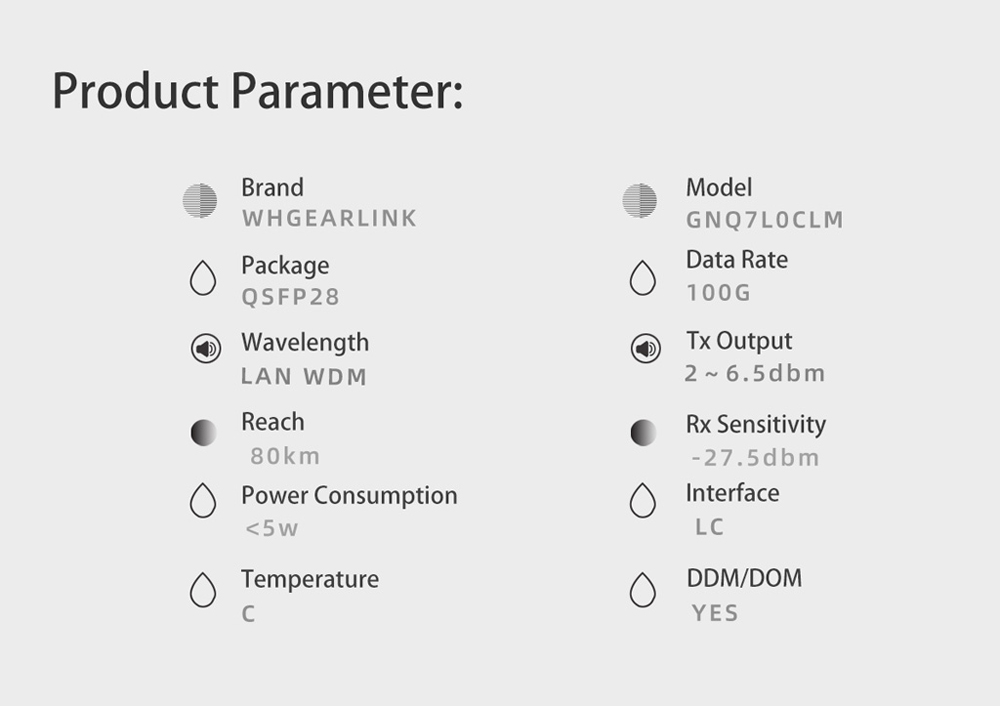
100G QSFP28 ZR4/100g zr4 qsfp28 optical transceiver is mainly used for data center switches, routers, and long-distance transmission connections. QSFP28 100g zr4 uses 4-channel 28G NRZ wavelength division multiplexing technology (LWDM4). It is a 4-channel full-duplex transceiver module, mainly used in 100G Scenarios such as Ethernet, data center, and telecommunications. It supports hot-swappable and packaged in QSFP28, the operating temperature is 0°C-70°C, the data rate can be as high as 103.125Gbps (4x25G NRZ) and transmission distance is up to 80km after optimization.
Parameter | Symbol | Min. | Max. | Unit | Notes |
Storage Temperature | TS | -40 | 85 | ºC | |
Supply Voltage | VCC | -0.5 | 3.6 | V | |
Relative Humidity (non-condensing) | RH | 5 | 95 | % | |
Data Input Voltage Differential | VIP-VDINl | - | 1 | V | |
Control Input Voltage | VI | -0.3 | VCC+0.5 | V | |
Control Output Current | IO | -20 | 20 | mA |
Parameter | Symbol | Min. | Typical | Max. | Unit | Notes |
Operating Case Temperature | TOP | 0 | - | 70 | ºC | |
Power Supply Voltage | VCC | 3.135 | 3.3 | 3.465 | V | |
Instantaneous peak current at hotplug | ICC_IP | - | - | 2000 | mA | 1 |
Sustained peak current at hotplug | ICC_SP | - | - | 1650 | mA | |
Maximum Power Dissipation | PD | - | - | 5 | W | |
Maximum Power Dissipation, Low Power Mode | PDP | - | - | 1.5 | W | |
Aggregate Bit Rate | ABR | - | 103.125 | - | Gb/s | |
Data Rate per Lane | DRL | - | 25.78 | - | Gb/s | |
Control Input Voltage High | VIA | VCC*0.7 | - | VCC+0.3 | V |
Parameter | Symbol | Min. | Typical | Max. | Unit | Notes |
Control Input Voltage Low | VIL | -0.3 | - | VCC*0.3 | V | |
Two-Wire Serial Interface Clock Rate | - | - | - | 400 | kHz | |
Module power supply noise tolerance 10 Hz - 10 MHz (peak-to-peak) | - | - | - | 66 | mVpp | |
Rx Differential Data Output Load | - | - | 100 | - | ohms | |
Operating Distance | - | 2 | - | 80,000 | m | Note |
Note OF qsfp28 zr4: 40km without FEC and 80km with FEC.
DWDM technology is also one of the application schemes of WDM technology, also called fine wavelength division multiplexing technology. DWDM technology can combine multiple optical wavelengths and transmit them with one optical fiber. The wavelength range of DWDM technology is 1525nm-1565nm (C band) and 1570nm-1610nm (L band), which is a small section taken from the CWDM wavelength range. The wavelength interval is 0.8nm. The channel interval of DWDM has different intervals such as 0.4nm, 0.8nm, and 1.6nm according to the needs.
The DWDM optical transceiver is a dense wavelength division multiplexing optical transceiver . The channel spacing of the DWDM optical transceiver has different spacings such as 0.4nm, 0.8nm, and 1.6nm according to the needs. If the spacing is small, additional wavelength control devices are required. Its main advantage is that it is a more effective way to solve line bandwidth expansion.
The main difference between DWDM optical transceiver s and ordinary optical transceiver s is the different working wavelengths. The working wavelengths of ordinary optical transceiver s are usually 850nm, 1310nm and 1550nm. The wavelength range of the DWDM optical transceiver is 1525nm-1565nm (C band) and 1570nm-1610nm (L band). The commonly used one is 1525nm-1565nm (C band). The wavelength interval of this band range is 0.8nm. The price of DWDM optical transceiver s is higher than that of ordinary optical transceivers.
Fine wavelength division multiplexing, Lan-WDM (Wavelength Division Multiplexing).
WDM bearer schemes include coarse wavelength division multiplexing (CWDM), dense wavelength division multiplexing (DWDM), medium wavelength division multiplexing (MWDM), and fine wavelength division multiplexing (LWDM).
LWDM is based on Ethernet channel wavelength division multiplexing Lan-WDM technology, also known as fine wavelength division multiplexing. Its channel spacing is 200~800GHz, which is between DWDM (100GHz, 50GHz) and CWDM (about 3THz). LWDM uses 12 wavelengths in the O-band (1260nm~1360nm) range from 1269nm to 1332nm, with a wavelength interval of 4nm (1269.23, 1273.54, 1277.89, 1282.26, 1286.66, 1291.1, 1295.56, 1300.05, 1304.538, 1313.9 , 1318.35nm). The LWDM operating wavelength is characterized by being located near zero dispersion, with small dispersion and good stability. At the same time, LWDM can support 12 waves of 25G, and the capacity is increased, which can further save optical fibers.

